d37d28b960d49ab692bd3a3f573bada0.ppt
- Количество слайдов: 134

RULES OF THE ROAD: BIOPTIC DRIVING Mary Ellen Keith, COTA, CDRS March 17, 2016

Should visually impaired people be allowed to drive? The Dilemma

What is Bioptic Driving? A method of driving which utilizes both general vision and magnified distant vision through intermittent use of a telescopic device.

Common Terminology Bioptic Telescopic Lens System – combination two lens optical system consisting of a standard or conventional pair of carrier lenses; and a miniature telescopic lens unit mounted permanently at a 10 degree angle to the upper or superior portion of the carrier lens. These devices, which are mounted in a sturdy frame presenting spring loaded hinges and adjustable nose pads. Charles P. Huss, COMP

Common Terminology Carrier lens- traditional spectacle lens-may have significant or insignificant correction.

Common Terminology Spotting or “dipping”the intermittent visual sampling of the distant driving area.

Common Terminology Rhythmic Use”- the ability to use the BTS. Duration 1 -2 seconds Frequency 4 -6 seconds or 8 -10 seconds Depends on: Visual Acuity Environment

Common Terminology Multiplexing- while spotting an object through their bioptic, they are still aware of objects in the peripheral vision.

What is Bioptic Driving? Spotting through the bioptic telescope is used for extremely short periods of time (1 -2 seconds max) The frequency of using the bioptic telescope is dependent upon the everchanging driving environment and the individual’s functional vision abilities related to their awareness acuity. (the presence of any form) The speed and the structure of the roadway (curve vs straight)

Bioptic Driving Approximately 95% of driving occurs using the subjects general vision (carrier). Brief viewing episodes (“spotting/dipping”) through the bioptic telescope provides more detailed information

Bioptic Telescopes Road sign sizes/locations are mostly standardized and based on assumptions that drivers will have a visual acuity of 20/40 NHTSA

Bioptic Telescopes Advantages More for driving detail for signs, signals and other features seen from a further distance

Benefits Once trained properly, a visually impaired driver is able to detect and identify detail and/or movement of distantly positioned objects or forms more effectively and confidently. Charles P. Huss, COMP

Carrier Lens View

Telescopic Components Miniature Telescopic Lens System • • • Can be monocular or binocular Can be frame or spectacle mounted Can be free standing

Types of Bioptic Systems Typical Magnification 2 X-5. 5 X Ocutech VES system- manual and auto focus Bi. Optic by Designs for Visionspectacle mounted Galilean or Keplerian telescopes Beecher- bilateral viewing system, separate from carrier lens system. Photos provided by Richard Windsor O. D. , FAAO- Low Vision Centers of Indiana

Types of Bioptic Systems DFV Galilean Conforma BITA DFV Eagle Eye VES Mini Designs for Vision EFTS Beecher Mirage VES-II, K, Sport

Newest Ocutech VES-SPORT Latest development in bioptic eyewear Brighter and wider visual field (12. 5 degrees) than previous VES systems Lightweight less 1 oz. Range of colors

Common Diagnoses ARMD Histoplasmosis MD Achromatopsia Retinitis Diabetic Pigmentosa Retinopathy Rod Cone Albinism Dystrophy Congenital Other Eye Nystagmus Diseases Stargardt’s

Bioptic Candidates? Poor Rod Cone dystrophies usually not candidates Retinitis Pigmentosa usually not candidates Glaucoma Other causes of peripheral field losses Richard Windsor OD, FAAO- Low Vision Centers of Indiana

Members of the Bioptic Team Optometrist or Ophthalmologist Examination: to determine type of: System Power Other features that will provide the safest and most efficient system for each patient Ability to spot with bioptic system Richard Windsor OD, FAAO- Low Vision Centers of Indiana

Members of the Bioptic Team Optometrist or Ophthalmologist Evaluate Eye health Ocular motor functions Depth perception Saccades/Pursuits Cover test, etc. Richard Windsor OD, FAAO- Low Vision Centers of Indiana

Members of the Bioptic Team Optometrist or Ophthalmologist Evaluate Nystagmus assessment Refraction Computerized Photostress Color visual fields test vision testing Richard Windsor OD, FAAO- Low Vision Centers of Indiana

Members of the Bioptic Team Optometrist or Ophthalmologist Evaluate Glare issues considered, prescribe filters/tints Test for neurological integrity Informal assessment of mental status Richard Windsor OD, FAAO- Low Vision Centers of Indiana

Members of the Bioptic Team Optometrist or Ophthalmologist –Training provided in office (training varies widely) –Homework to increase skill

Members of the Bioptic Team Occupational Therapist/Driver Rehabilitation Specialist Evaluation / training using telescope in car Facilitator with the license branch BMV Licensing Authority/ Provide Road Test Monitor yearly exams and renewals

Considerations by Licensing Authorities BMV may impose… Special driving tests Past driving experience Closer monitoring of driving record Anticipated driving needs More frequent vision and Causative disorder driving tests Other health issues Restrictions on routes, (sensory, motor, time of day, interstate cognitive) driving, radius, etc.

Who is the Typical Bioptic Driver? Stable vision Meet State mandated vision requirements for distant acuity and peripheral vision International Council Ophthalmology: (http: //www. icoph. org)

Criteria Required for Bioptic Driving Adequate Color Vision Normal Head, Neck and Eye Mobility Must be Cognitively Intact Free of Visual Attention Deficits

Criteria Required for Bioptic Driving No Impulsive Tendencies Able to Accept Constructive Criticism Highly Motivated, Dedicated, Hard Working and Goal Orientated

Indiana’s Criteria Required for Bioptic Driving Visual Acuity Accepted up to 20/200* with best correction (through carrier. Indiana BMV) 20/40 with Bioptic Telescopes (Indiana BMV) Field of View: 120° continuous (Indiana BMV) * will vary from State to State

Indiana Bioptic Program Procedures Referral Information: provided by the referring low vision optometrist or ophthalmologist Rx Certificate of vision for Indiana BMV Supporting test data (computerized diagnostics)

Indiana Bioptic Program Procedures Performed by the Bioptic Driver Rehabilitation Specialist Evaluation: Clinical BTW (passenger only in Indiana)

Indiana Bioptic Program Procedures Copy of Evaluation: Referring Funding BMV Low Vision Specialist Source

Indiana Bioptic Program Procedures BMV Report: Medical Review Board Periodic review and consideration by the current vision professional on the Bureau of Motor Vehicles for Indiana

Indiana Bioptic Program Procedures If Approved: Letter sent to client to proceed to BMV branch for learner’s permit

Indiana Bioptic Program Procedures Clients responsibility: Local license branch to obtain bioptic learners permit Only for training with a bioptic telescope and with a State recognized bioptic trainer

Indiana Bioptic Program Procedures Indiana requirements: 30 hours of behind-the-wheel for previous driver 50 hours for new drivers Completion of required hours or safe status Extended examiner road test with a senior BMV

Indiana Bioptic Program Procedures Annual Examination Report to BMV A yearly eye exam is required with their low vision specialist (Indiana) Night driving is a restriction Unless vision specialist requests night drive New drivers will need 10 hours on night driving

Payer Source Private Pay Vocational Rehab Workmen’s Compensation


Bioptic Evaluation Process Clinical Evaluation: History Vision stability How What long? do they have the most difficulty seeing?

Bioptic Evaluation Process Clinical Evaluation Past driving history New Past vs. experienced driver driving problems leading to bioptic options

Bioptic Evaluation Process Clinical Evaluation Ø Review of vision information provided by low vision specialist Ø Certificate of Vision for Bioptic Drivers

RHI Clinical Evaluation: Trails A&B Visual perceptual Road Sign Identification (pen & paper) Road Sign Quiz Shapes of Traffic Signs Color of Road Signs Traffic Light Recognition Traffic Light Placement Understand Turn Signals Arrow

Road Sign Quiz

Traffic Shapes

Black/White Traffic Shapes

Traffic Sign Colors

Traffic Light Placement

Traffic Arrow Placement

Five Light Traffic Placement

Clinical Evaluation: Visual scanning efficiency Stationary Spotting Skills in Clinic (telescope practice)

Bioptic Road Signs Scan Board

Bioptic Wall Strip William Feinbloom, O. D. , Ph. D.

In-Vehicle Evaluation (passenger) Using The Bioptic Telescopic System (BTS) Ø In-Vehicle Evaluation as passenger only • Establish baseline for the BTS for stationary and dynamic spotting

In-Vehicle Evaluation (passenger) Using The Bioptic Telescopic System (BTS) First determine the quality of general vision in the carrier lenses Static/Dynamic: identify what can be seen clearly in the carrier lenses.

In-Vehicle Evaluation (passenger) Using The Bioptic Telescopic System (BTS) Four basic tasks required using the BTS: Identify still objects while stopped (poles, building, signs, etc. )

Passenger Using The Bioptic Telescopic System (BTS) Identify moving objects while stopped (vehicles on street).

Passenger Using The Bioptic Telescopic System (BTS) Identify still objects while moving (traffic lights, signs, parked cars)

Passenger Using The Bioptic Telescopic System (BTS) Identify moving objects while moving, (vehicles, brake lights, turn signals, pedestrians/bicyclist)

Observation of Passenger Ability to move smoothly and quickly into/out of BTS Identify color of traffic light: Carrier lens and bioptic telescope

Observation of Passenger Identify: Stop signs, speed limit signs, and caution signs Identify all pedestrians/bicyclists Identify Sign construction worker: and worker blend together



Home Activities Stationary: Dr. Richard Windsor’s Homework Playing Cards Outside Objects in yard/neighborhood Dynamic: Bird Watching Cars Pedestrians/Bicyclists Sports Events Basketball Hockey

Walking Program Downtown Area: Spot Lights Signs Cars passing Bicyclists Teach Lane Markings One Way Street Markings



Puzzlement of Signage

Spotting vs. Reading Ice on bridge Right turn lane only Right lane must turn right Construction signs Pavement narrows

Difficulties Not observing road signs May run a stop sign, not identifying a school zone, difficulty observing white regulatory signs Unable to read lengthy signs




Regulatory Signs Right Lane Must Turn Right White Square With Black lettering


Warning Signs ♦ Pedestrian Crossing Single Person vs. Two People ♦ School Zone


Major Problems

Skills to Teach How often should they check their scope? Depends on acuity and performance 20/70 vs. 20/200 20/70 As needed Unfamiliar Areas; Check scope possibly every 8 -10 seconds 20/200: Check scope every 4 -6 seconds or as needed

Traffic Lights Yellow “Easiest” Stands Out Red Depends on Color of Background Lighting Green Usually the Hardest Lighting Green Trees vs. Blue Sky

I thought it might be a red light!!!!! Bioptic Driver

Hitting brakes before intersection Strategy: Coast 2. Scope 3. Clues (Environment) Traffic patterns, brake lights 4. Repeat 1.

Traffic Light Confusion Flashing Lights Spotting Incorrect Lights Close Together Right Arrow Lights (Unusual) Green Arrows Lights (Difficult) Windy Conditions Traffic Light Position Changes


Lights Close Together


More Difficulties? I Love Strategies

Strategy Unsure What Lane to Select Approaching Intersections Going Straight: Two Lanes = Right Lane Three Lanes = Middle Lane

Skills For Traffic Lights on Curves Lights in Dips

Lights on Curves


Difficulty Spotting Stop Sign Hidden Stop Sign Glare Shade Bioptic Placement on Left Eye

Strategies for Stop Signs Turn head to right Count the stop signs Back side of the stop sign Identify the post line Cross traffic


Loss of Lane Position Lower Speeds vs. Higher Speeds = Decrease in Peripheral

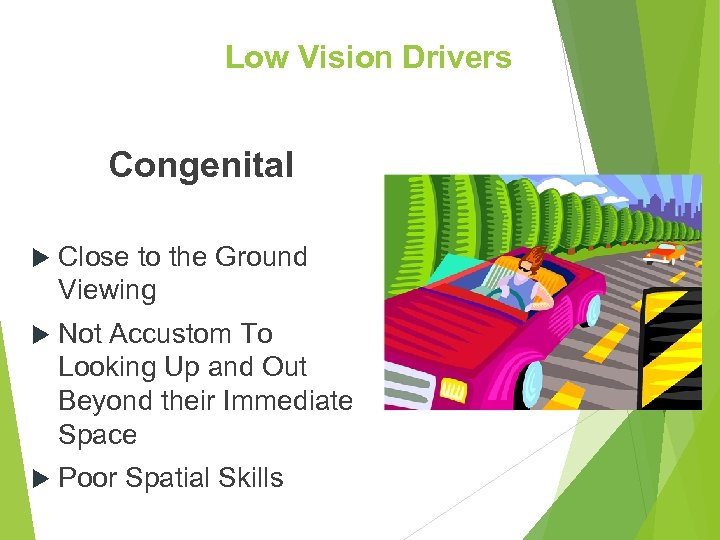
Low Vision Drivers Congenital Close to the Ground Viewing Not Accustom To Looking Up and Out Beyond their Immediate Space Poor Spatial Skills

Low Vision Drivers Nystagmus Stress Emotional state Fatigue Battling glare and light Direction of view Null position

Low Vision Drivers Nystagmus Overflow of Motor Skills “ping-pong” steering Stress = Increases Loss of Lane Position Late Lane Drift Correction

Previous Drivers Loss of Lane Position Difficulties Drives Close to Edge (Right/Left) Strategies Yellow Line Easiest to See Poor Contrast Previous Habits Already Understand Concept of Centering Verbal Cues to Reposition Vehicle Reference Points

Teaching Tools for Spatial Deficits Reference Tape (Windshield) Visual Reference Pole/Poles Dash Taping EVA Targeting Alignment Other

Reference Tape

Reference Poles
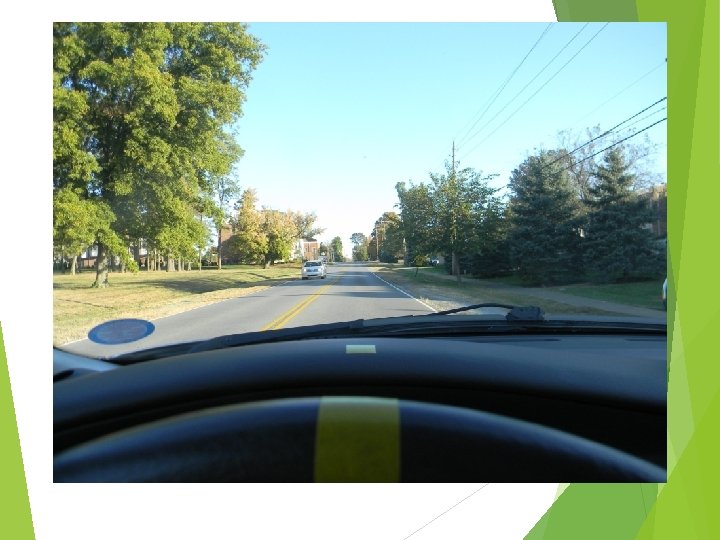

Glare Biggest Roadblock Can’t Ignore It! Doesn’t Disappear Depends On Weather and Time Of Day
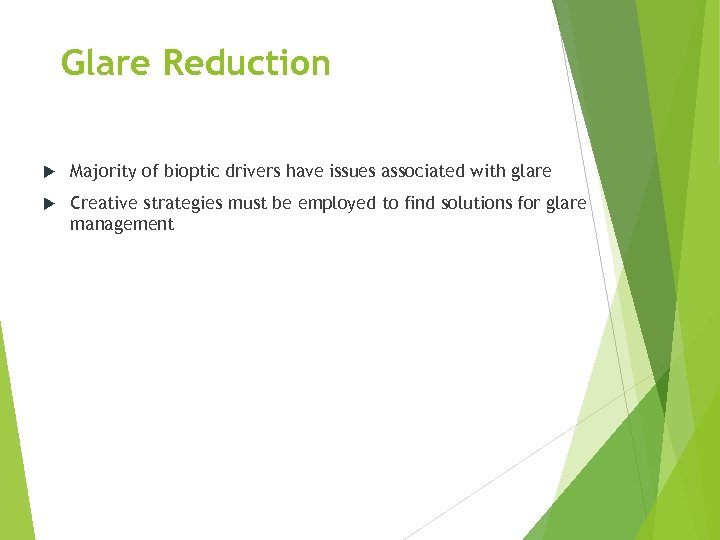
Glare Reduction Majority of bioptic drivers have issues associated with glare Creative strategies must be employed to find solutions for glare management

Sun Filters/Shades Separate Shade or a Filter on Bioptic device Decrease glare and light sensitivity Variety of filters may be required Different lighting conditions=different filters Helps to identify lights Minimize squinting Possible ill after session Decreases fatigue Remove in shaded areas Creative strategies must be employed to find solutions for glare management



Hats


Glare Control (Filters) Shades

Dashboard Glare Reduction

Accommodation Problems Difficulty with seeing speedometer Mark numbers with color tape arrow Mark gas gauge

Accommodation

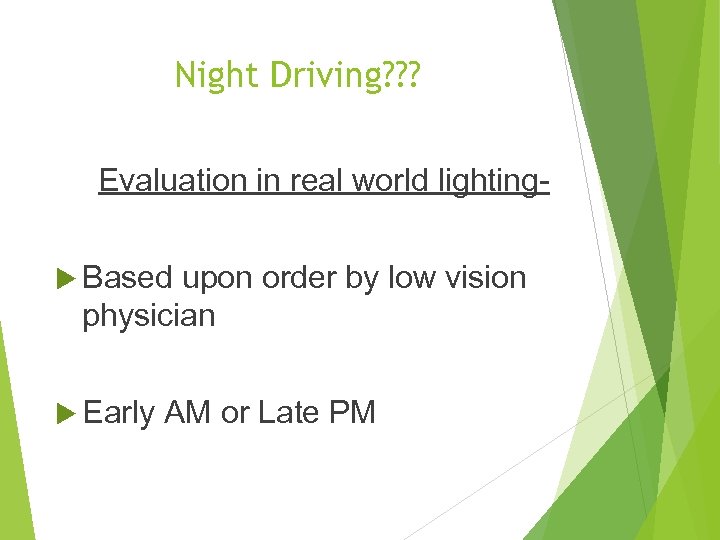
Night Driving? ? ? Evaluation in real world lighting Based upon order by low vision physician Early AM or Late PM

Night Driving? ? ? During initial training or following a specified period of daytime driving success Report to BMV with appropriate recommendations

Night Driving Evaluation Common Problems: Lane centering Headlight glare Response to hazards

Night Driving Evaluation Stops/Limit Line Difficulty identifying curb or median Observation Hazard identification / avoidance Signs/signals

Night Driving Evaluation Gap Acceptance Following distance Gap selection

Night Driving Achromats Lights pop out Difficulty detecting color of flashing lights Red vs. Yellow Unable Head light glare Head to see the traffic light box (Amanda) light glare from their vehicles on signs Certain color of signs may be poor contrast

It Looks like a Black Light! Red Contacts Lenses Help to: Enhance the color red Brake lights, traffic lights and red road signs VS
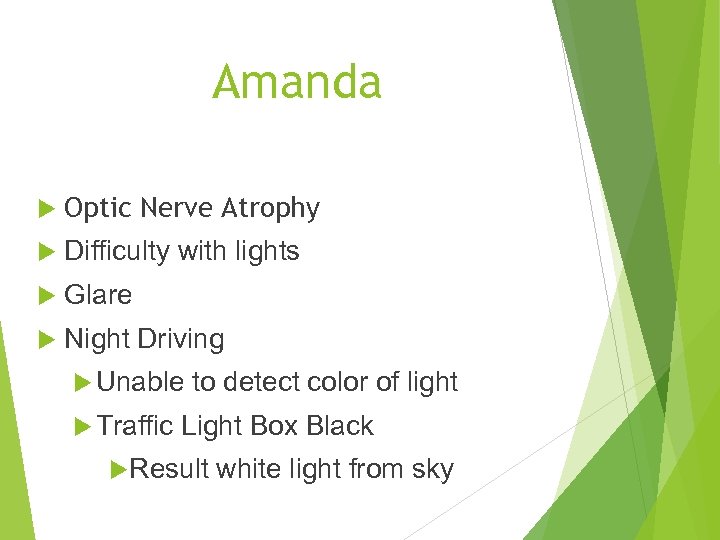
Amanda Optic Nerve Atrophy Difficulty with lights Glare Night Driving Unable Traffic to detect color of light Light Box Black Result white light from sky

Amanda

Magenta Filter

Carrier Position
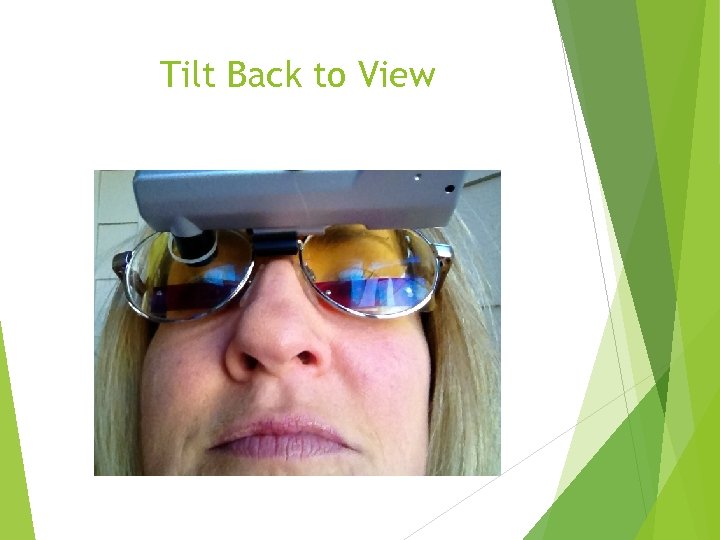
Tilt Back to View

In the end remember… Bioptic telescopes do not restore vision to normal No two individuals with the same visual disorder will function or interpret the world around them the same

In the end remember… Bioptic telescope does not guarantee ability to pass driving test Bioptic drivers remain at a visual disadvantage and will always need to drive with extra caution
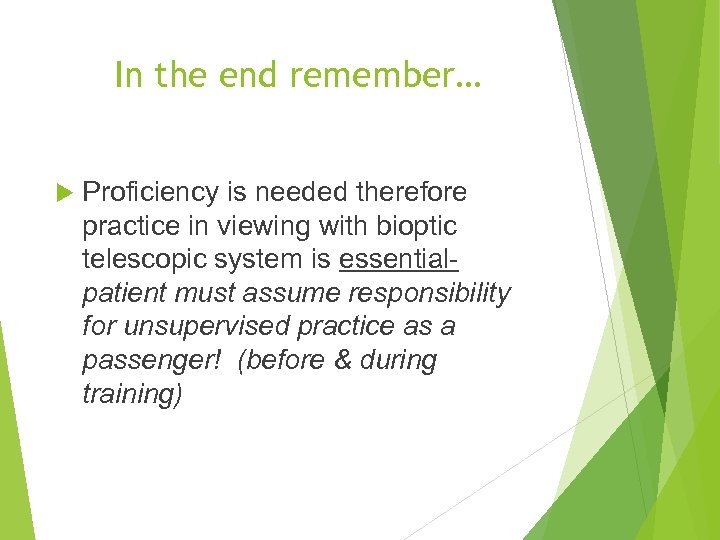
In the end remember… Proficiency is needed therefore practice in viewing with bioptic telescopic system is essentialpatient must assume responsibility for unsupervised practice as a passenger! (before & during training)

d37d28b960d49ab692bd3a3f573bada0.ppt